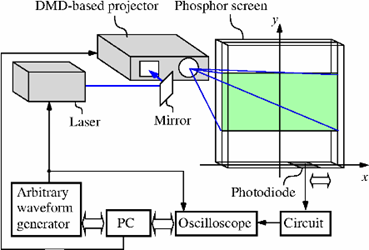Japanese Scientists Build Power-Harvesting Photoluminescent Display
By Jof Enriquez,
Follow me on Twitter @jofenriq

Scientists at Ritsumeikan University in Kyoto, Japan have demonstrated via a proof-of-concept experiment how to convert a luminescent solar concentrator (LSC) into an energy-harvesting laser phosphor display by projecting intensity-modulated light on it.
LSCs are touted to be cheaper to build and more efficient at harvesting solar or light energy than traditional and more expensive silicon-based solar cells. An LSC consists of a transparent piece of plastic or glass sheet painted with a luminescent dye, which absorbs light at certain wavelengths. This creates a glow, which propagates by total internal reflection to the edge of the sheet, where the light is absorbed by a comparatively small area of expensive solar cells, according to the Clean Energy Institute.
Now, in a unique study, the researchers at Ritsumeikan University sought to turn an LSC into a high-resolution display while retaining the ability to harvest energy. In order to do this, they replaced the phosphor screen in a laser phosphor display (LPD) with a luminescent solar concentrator (LSC).
The researchers fabricated a 95 mm × 95 mm × 10 mm screen by sandwiching a thin layer of the laser dye coumarin 6 between two acrylic plates, which guided the photoluminescent (PL) photons emitted in both directions toward their edge surfaces.
Then, the researchers removed the original light source in a digital micromirror device (DMD)-based commercial grade projector and projected a blue laser beam into its optics. This resulted in the display of green images of a resolution test chart on the phosphor screen.
In order to record the power of the PL photons, they attached photodiode with a 10 × 10 mm sensitive area on the bottom edge of the screen.
"Its output indicates that a fully covered version would harvest up to 71 percent of the incoming laser power," the researchers wrote of their experiment's results in an article titled "Energy-harvesting laser phosphor display and its design considerations," which is co-authored by Ichiro Fujieda, Shunsuke Itaya, Masamichi Ohta, Yuuki Hirai, and Takamasa Kohmoto, and published in the Journal of Photonics for Energy.
The researchers minimized the effect of self-absorption through the seamless tiling of small modules, which was achieved by attaching an output coupler to the wave guiding plate and extracting PL photons in each module.
Initial display output included a noticeable ghost image, which was produced by the reflection of PL photons off the rear plate-air interface. The research team later eliminated this kind of optical crosstalk by facing the transparent plate toward the projector thinner.
Journal of Photonics for Energy associate editor Loucas Tsakalakos, in a news release, described the Japanese team's research as “a unique and novel application of a luminescent solar concentrator for display applications. The work shows practical operation of such a device, describes the basic operational principle and expected energy harvesting capability of such a system, and describes ways of improving the design in future work.”
